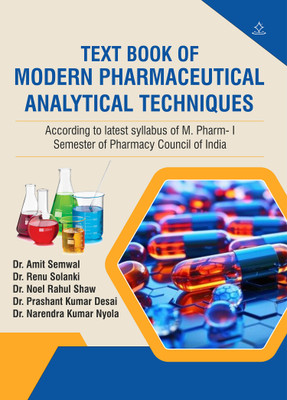TEXT BOOK OF MODERN PHARMACEUTICAL ANALYTICAL TECHNIQUES - According to latest syllabus of M. Pharm- I semester of Pharmacy Council of India(Paperback, Dr. Amit Semwal, Dr. Renu Solanki, Dr. Noel Rahul Shaw, Dr. Prashant Kumar Desai, Dr. Narendra Kumar Nyola)
Quick Overview
Product Price Comparison
The "Textbook of Modern Pharmaceutical Analytical Techniques" provides a comprehensive and methodical understanding of various analytical tools crucial for pharmaceutical research and quality control. It begins with fundamental spectroscopic methods such as UV-Visible and IR spectroscopy, detailing their theory, instrumentation, solvent effects, and practical applications in pharmaceutical analysis. The book progresses to advanced techniques like NMR and Mass Spectroscopy, offering insights into their principles, structural elucidation capabilities, and technical aspects like ionization methods and analyzers. Spectrofluorimetry and atomic techniques such as Flame Emission and Atomic Absorption Spectroscopy are thoroughly discussed, including their instrumentation and interferences. A major highlight is the detailed section on Chromatography, covering a wide array of techniquesŌĆöpaper, TLC, ion exchange, column, gas, HPLC, and affinity chromatographyŌĆöalong with their principles, resolution factors, and pharmaceutical applications. The textbook also includes Electrophoresis methods, explaining paper, gel, capillary, and iso-electric focusing techniques, each with working conditions and analytical significance. The chapter on X-ray Crystallography provides foundational knowledge on crystal structures, BraggŌĆÖs law, and diffraction techniques essential for drug molecule characterization. Finally, it explores Immunological assays like RIA, ELISA, and bioluminescence assays, underscoring their critical role in diagnostic and therapeutic monitoring. This book is not only a valuable academic resource for pharmacy and analytical chemistry students but also serves as a practical guide for laboratory professionals involved in pharmaceutical quality assurance and research. Through clear explanations and structured content, it bridges theoretical concepts with real-world analytical challenges in the pharmaceutical industry.

